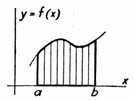
COURSE INFO
SCHEDULE
SYLLABUS
HOMEWORK
WRITING ASSIGNMENTS
OFFICE HOURS
|
Math 125, Spring 2004
Calculus 1
Writing Assignments
Give brief but clear answers to the questions below. Click on this link to send me an email with your answers. Make sure to type 'Calculus Assignment' and the date in the subject line.
For Friday, April 2
Section 1.21: Differential Equations
- How do the techniques in this chapter `reverse' the process of differentiation we've learned to date?
- What are the two types of differential equations mentioned in the section? How are they different?
- Which function is its own derivative? How are trig functions related to their higher derivatives?
For Monday, April 5
Section 1.22: Applications of DE's
- How does our interpretation of the derivative as a rate help us to express mathematically the exercises on page 51?
- Write a rate question similar to those on page 51, that is, some question that gives information about the rate of a phenomenon.
For Wednesday, April 7
Section 1.24: Limits Involving Infinity (NOTE THAT WE'VE SKIPPED SECTION 1.23)
- What sorts of functions have horizontal asymptotes? What sorts of functions have vertical asymptotes?
- What do we actually mean when we say 'The limit as x approaches c of f(x) is infinity'?
- Recall what a rational function is from section 1.2. When does a rational function have a horizontal asymptote? When does a function have a horizontal asymptote that is not y=0?
For Friday, April 9
Section 1.25: L'Hopitals Rule
- Give a verbal explanation of how L'Hopitals rule is used to evaluate limits. Be careful to say what form the function must be in to apply the rule.
- How can we use L'Hopitals rule to evaluate limits?
- Find another word that uses a circumflex in its spelling. :)
For Monday, April 12
Sections 1.26 and 1.27: The Mean Value Theorem and its Applications
- Compare the Mean Value Theorem to the Intermediate Value Theorem. How can we interpret the MVT in terms of slopes?
- Explain the connection between Rolle's Theorem and the Mean Value Theorem. Go into greater detail than the section.
- If two functions have the same derivative, must they be equal? If they are not equal, how are they related?
For Wednesday, April 14
Section 1.28: Concavity and Inflection Points
- We know that the first derivative of a function measures its slope. What does the second derivative measure?
- What is an inflection point?
- If the college says that 'Tuition is going up only 3% this year, which is the third straight year that the increase in tuition has gone down,' then what shape is the graph of tuition with respect to time?
For Friday, April 16
NO CLASS
There will be an exam in a week, however, so use this time away from class to review the material to date and determine what you need to work most on before the exam.
For Monday, April 19
Section 1.29: Velocity and Acceleration
- How are velocity, acceleration, and jerk all related?
- What process lets us find a function given its derivative? Where have we seen this before?
- What is the velocity of a projectile when it reaches its maximum height? Why is this the case?
For mild amusement, click here and watch any of the last four videos in the 'Velocity and Acceleration' section
For Wednesday, April 21
Review for Exam 3
You may download a copy of the practice exam here . Please come to class prepared to discuss this as well as any other questions you have on the material thus far.
For Friday, April 23
Exam the Third
- Study hard and get plenty of rest the night before.
- PLEASE come talk to me in advance about any topics that you're having trouble with.
For Monday, April 26
Section 1.30: Polynomial Approximation
- (You'll need a graphing utility or a creative imagination for this first exercise.) If we zoom in really close to a point on a continuous and differentiable function, what does the graph look like? What equation (other than the function itself) describes what we see?
- Why might it be useful to approximate a function with polynomials?
- How do polynomial approximations explain how your calculator is able to figure out something like sin(2.573) in under a second?
For Wednesday, April 28
Section 1.31: Newton's Method
- What is the purpose of Newton's Method?
- What does the word iterative mean and how does it apply to Newton's Method?
- What happens if, at some point during the interation of Newton's Method, you get that x n+I = x n ? (Hint: Look at the formula used in the iteration.
For Friday, April 30
Section 1.32: Implicit Differentiation
- What technique allows us to find slopes of curves that are not functions of one variable?
- Why is implicit differentiation an extension of the chain rule.
- We have seen implicit differentiation twice before in this course, namely to find derivatives of two types of functions. Which two types?
Click on this link to send me an email with your answers. Make sure to type 'Calculus Assignment' and the date in the subject line.
Barry Balof's Home Page
Whitman Math Home
Whitman College Home
|
